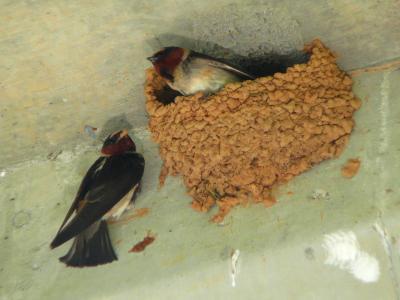People who live in cities love the infrastructure, the nightlife, the hobos, the fact that you can find a Starbucks on every corner. People who live in the country love the cleaner air, the openness, the fact that you can go for a walk without being accosted by hobos.
Is it just personal choice? If so, birds face many of the same dilemmas about how best to live life. Larger groups bring risks of disease and aggression by neighbors.
What other factors may be involved?
One possible explanation is that animals and birds might be genetically influenced to breed in smaller or larger colonies, an idea that began to gain traction in 2000, when Charles and Mary Brown reported the results of a large field experiment using Cliff Swallows, a species of American swallow that breeds in colonies of variable size.
Some individuals appear to be more resistant to nest parasites so can breed in larger, more parasite-infested colonies where they can achieve higher foraging efficiencies by following their many neighbors to the insect swarms on which they feed. The researchers cross-fostered 2,000 nestlings from nests in small colonies to nests in large colonies and vice versa and recaptured over 700 of the birds when they returned to breed in the following years.

A pair of cliff swallows building a nest. Credit: Ken Thomas
Analysis of the data showed that swallows hatched in larger colonies (but reared in smaller ones) chose to breed in large colonies, whereas the reverse was true for swallows hatched in small colonies.
In other words, the birds' choice is determined by genetic factors.
So it's genetic. Or is it regression to the mean?
Appealing though the conclusion might be, something does not sound quite right. How would a genetic component of the choice of group size be selected and maintained throughout evolution? Étienne Danchin of the University of Toulouse and Richard Wagner of the Vetmeduni's Konrad Lorenz Institute of Ethology wondered whether the results might not be influenced too much by the experimental design.
Together with Éric Wajnberg, a modelling specialist at the INRA in Sophia Antipolis, they simulated the data in the original paper and found that the results could be generated by chance.
The problem stems largely from the fallacy known as "regression to the mean" (RTM), which was first identified by Sir Francis Galton, a cousin of Charles Darwin, in the 19th century. It results from the fact that uncommonly large or small measurements are generally followed by more normal measurements simply because normal values are by definition far more common than extreme ones.
In the Browns' experiment, when individuals are fostered from small to large colonies they will on average recruit to colonies that are statistically smaller than their foster colony because these are closer to the mean colony size and vice versa.
Danchin and Wagner actually found a second problem with the original data analysis. The so-called "spatial fallacy" was discovered by Arie van Noorwijk in 1984 and occurs when the set of potential dispersal sites differs among individuals according to where they were born. Together the two fallacies can account for the experiment's results, even in the absence of an inherited component of the selection of colony size.
A question of design
The latest calculations are important for two reasons. First, they call the original conclusions into question and should thus encourage researchers to reconsider the role of genetic factors in certain behavioral decisions. Secondly, they sound a clear warning to all those working in behavioral science.
As Wagner says, "The biggest shock is that the very experimental design that is widely used to control for all extraneous effects actually creates the RTM fallacy. Even the most carefully designed studies can suffer from the problem, making their results invalid." Fortunately the scientists have proposed a way to avoid both pitfalls. Their simulations showed that restricting comparisons to individuals with the same set of options (in the present case by fostering all offspring to a single colony) can give rise to data that are immune to the pitfalls.





Comments